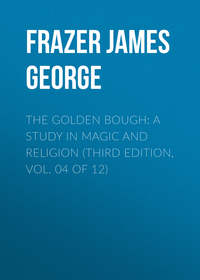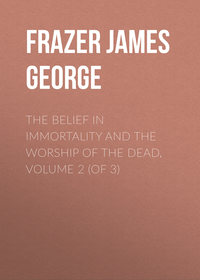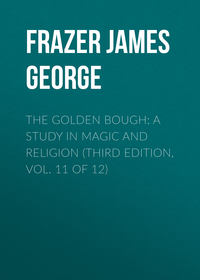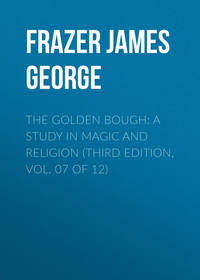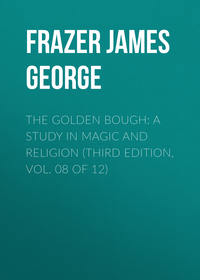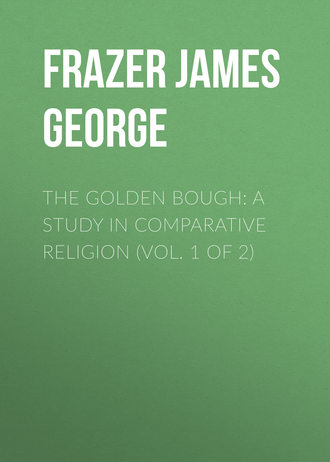
The Golden Bough: A Study in Comparative Religion (Vol. 1 of 2)
841
E. Meier, Deutsche Sagen, Sitten und Gebräuche aus Schwaben p. 374; cp. Birlinger, Volksthümlichesaus Schwaben, ii. 55.
842
E. Meier, op. cit. p. 372.
843
E. Meier, op. cit. p. 373.
844
E. Meier, op. cit. pp. 373, 374.
845
A. Kuhn, Sagen, Gebräuche und Märchen aus Westfalen, ii. 130.
846
F. J. Wiedemann, Aus dem inneren und äusseren Leben der Ehsten, p. 353.
847
E. Meier, op. cit. p. 374.
848
H. Pröhle, Harzbilder, p. 54.
849
Aug. Witzschel, Sagen, Sitten und Gebräuche aus Thüringen, p. 193.
850
Witzschel, op. cit. p. 199.
851
Grimm, Deutsche Mythologie,4 ii. 642.
852
Reinsberg-Düringsfeld, Fest-Kalender aus Böhmen, p. 90 sq.
853
Reinsberg-Düringsfeld, op. cit. p. 91.
854
Grimm, Deutsche Mythologie,4 ii. 639 sq.; Mannhardt, Baumkultus, p. 412.
855
Grimm, op. cit. ii. 644; K. Haupt, Sagenbuch der Lausitz, ii. 55.
856
Grimm, op. cit. ii. 640, 643.
857
Vernalecken, Mythen und Bräuche des Volkes in Oesterreich, p. 294 sq.; Reinsberg-Düringsfeld, Fest-Kalender aus Böhmen, p. 90.
858
Grimm, Deutsche Mythologie,4 ii. 640.
859
J. A. E. Köhler, Volksbrauch, Aberglauben, Sagen und andre alte Ueberlieferungen im Voigtlande, p. 171.
860
Reinsberg-Düringsfeld, Das festliche Jahr, p. 80.
861
Ralston, Songs of the Russian People, p. 211.
862
Ib. p. 210.
863
Grimm, Deutsche Mythologie,4 ii. 652; H. Usener, “Italische Mythen,” in Rheinisches Museum, N. F. xxx. (1875) p. 191 sq.
864
G. Pitrè, Spettacoli e feste popolari siciliane (Palermo, 1881), p. 207 sq.
865
Archivio per lo studio delle tradizioni popolari, iv. (1885) p. 294 sq.
866
H. Usener, op. cit. p. 193.
867
Vincenzo Dorsa, La tradizione greco-latina negli usi e nelle credenze popolari della Calabria citeriore (Cosenza, 1884), p. 43 sq.
868
Grimm, Deutsche Mythologie,4 ii. 652; H. Usener, “Italische Mythen,” in Rheinisches Museum, N. F. xxx. 1875, p. 191 sq.
869
Reinsberg-Düringsfeld, Fest-Kalender aus Böhmen, p. 89 sq.; W. Mannhardt, Baumkultus, p. 156. This custom has been already referred to. See p. 82.
870
Reinsberg-Düringsfeld, Das festliche Jahr, p. 82; Philo vom Walde, Schlesien in Sage und Brauch (N.D. preface dated 1883), p. 122.
871
Witzschel, Sagen, Sitten und Gebräuche aus Thüringen, p. 192 sq.
872
Grimm, Deutsche Mythologie,4 ii. 643 sq.; K. Haupt, Sagenbuch der Lausitz, ii. 54 sq.; Mannhardt, Baumkultus, p. 412 sq.; Ralston, Songs of the Russian People, p. 211.
873
Grimm, op. cit. ii. 644; K. Haupt, op. cit. ii. 55.
874
E. Gerard, The Land beyond the Forest, ii. 47-49.
875
This is also the view taken of the custom by Mannhardt, Baumkultus, p. 419.
876
Vernalecken, Mythen und Bräuche des Volkes in Oesterreich, p. 293 sq.
877
Reinsberg-Düringsfeld, Das festliche Jahr, p. 82.
878
Philo vom Walde, Schlesien in Sage und Brauch, p. 122.
879
Grimm, Deutsche Mythologie,4 ii. 640 sq.
880
See above, p. 260.
881
K. Schwenk, Die Mythologie der Slawen, p. 217 sq.
882
Above, p. 263.
883
See above, pp. 83, 263.
884
Above, p. 263, and Grimm, Deutsche Mythologie,4 ii. 644; Reinsberg-Düringsfeld, Fest-Kalender aus Böhmen, p. 87 sq.
885
Above, p. 263.
886
See above, p. 266 sqq.
887
Above, pp. 257, 259, 265; and Grimm, D. M.4 ii. 643.
888
Reinsberg-Düringsfeld, Fest-Kalender aus Böhmen, p. 88. Sometimes the effigy of Death (without a tree) is carried round by boys who collect gratuities. Grimm, D. M.4 ii. 644.
889
Above, p. 243.
890
Wiedemann, Aus dem inneren und äusseren Leben der Ehsten, p. 353; Holzmayer, “Osiliana,” in Verhandlungen der gelehrten Estnischen Gesellschaft zu Dorpat, vii. Heft 2, p. 10 sq.; W. Mannhardt, Baumkultus, p. 407 sq.
891
W. Mannhardt, Baumkultus, pp. 417-421.
892
Ralston, Songs of the Russian People, p. 221.
893
Ralston, op. cit. p. 241.
894
Ralston, op. cit. p. 243 sq.; W. Mannhardt, Baumkultus, p. 414.
895
W. Mannhardt, Baumkultus, p. 414 sq.; Ralston, op. cit. p. 244.
896
Ralston, op. cit. p. 245; W. Mannhardt, Baumkultus, p. 416.
897
W. Mannhardt, l. c.; Ralston, l. c.
898
Grimm, Deutsche Mythologie,4 ii. 644.
899
J. G. von Hahn, Albanesische Studien, i. 160.
900
Captain R. C. Temple, in Indian Antiquary, xi. (1882) p. 297 sq.
901
See above, p. 94 sqq.
902
Above, p. 70 sqq.
903
Baudissin, Studien zur semitischen Religionsgeschichte, i. 299; W. Mannhardt, Antike Wald- und Feldkulte, p. 274.
904
Plutarch, Alcibiades, 18; Zenobius, Centur. i. 49; Theocritus, xv. 132 sq.; Eustathius on Homer, Od. xi. 590.
905
Besides Lucian (cited below) see Jerome, Comment. in Ezechiel. viii. 14, in qua (solemnitate) plangitur quasi mortuus, et postea reviviscens, canitur atque laudatur … interfectionem et resurrectionem Adonidis planctu et gaudio prosequens.
906
Theocritus, xv.
907
W. Mannhardt, op. cit. p. 277.
908
Lucian, De dea Syria, 6. The words ἐς τὸν ἠέρα πέμπουσι imply that the ascension was supposed to take place in the presence, if not before the eyes, of the worshipping crowds.
909
Lucian, op. cit. 8. The discoloration of the river and the sea was observed by Maundrell on 17/27th March 1696/1697. See his “Journey from Aleppo to Jerusalem,” in Bohn's Early Travels in Palestine, edited by Thomas Wright, p. 411. Renan observed the discoloration at the beginning of February; Baudissin, Studien, i. 298 (referring to Renan, Mission de Phénicie, p. 283). Milton's lines will occur to most readers.
910
Ovid, Metam. x. 735, compared with Bion i. 66. The latter, however, makes the anemone spring from the tears, as the rose from the blood of Adonis.
911
W. Robertson Smith, “Ctesias and the Semíramis legend,” in English Historical Review, April 1887, following Lagarde.
912
In the Alexandrian ceremony, however, it appears to have been the image of Adonis only which was thrown into the sea.
913
Apollodorus, Biblioth. iii. 14, 4; Schol. on Theocritus, i. 109; Antoninus Liberalis, 34; Tzetzes on Lycophron, 829; Ovid, Metam. x. 489 sqq.; Servius on Virgil, Aen. v. 72, and on Bucol. x. 18; Hyginus, Fab. 58, 164; Fulgentius, iii. 8. The word Myrrha or Smyrna is borrowed from the Phoenician (Liddell and Scott, Greek Lexicon, s. v. σμύρνα). Hence the mother's name, as well as the son's, was taken directly from the Semites.
914
Schol. on Theocritus, iii. 48; Hyginus, Astronom. ii. 7; Lucian, Dialog. deor. xi. 1; Cornutus, De natura deorum, 28, p. 163 sq. ed. Osannus; Apollodorus, iii. 14, 4.
915
Thus, after the autumnal equinox the Egyptians celebrated the “nativity of the sun's walking-sticks,” because, as the sun declined daily in the sky, and his heat and light diminished, he was supposed to need a staff with which to support his steps. Plutarch, Isis et Osiris, 52.
916
Schol. on Theocritus, iii. 48, ὁ Ἄδωνις, ἤγουν ὁ σῖτος ὁ σπειρόμενος, ἒξ μῆνας ἐν τῇ γῇ ποιεῖ ἀπὸ τῆς σπορᾶς, καὶ ἒξ μῆνας ἔχει αὐτὸν ἡ Ἀφροδίτη, τουτέστιν ἡ εὐκρασία τοῦ ἀέρος. καὶ ἐκτότε λαμβάνουσιν αὐτὸν οἱ ἄνθρωποι. Jerome on Ezech. c. viii. 14. Eadem gentilitas hujuscemodi fabulas poetarum, quae habent turpitudinem, interpretatur subtiliter interfectionem et resurrectionem Adonidis planctu et gaudio prosequens: quorum alterum in seminibus, quae moriuntur in terra, alterum in segetibus, quibus mortua semina renascuntur, ostendi putat. Ammianus Marcellinus, xix. 1, 11, in sollemnibus Adonidis sacris, quod simulacrum aliquod esse frugum adultarum religiones mysticae docent. Id. xxii. 9, 15, amato Veneris, ut fabulae fingunt, apri dente ferali deleto, quod in adulto flore sectarum est indicium frugum. Clemens Alexandr. Hom. 6, 11 (quoted by W. Mannhardt, Antike Wald- und Feldkulte, p. 281), λάμβανουσι δὲ καὶ Ἄδωνιν εἰς ὡραίους καρπούς. Etymolog. Magn. Ἄδωνις κύριον; δύναται καὶ ὁ καρπὸς εἶναι ἄδωνις; οἷον ἀδώνειος καρπός, ἀρέσκων. Eusebius, Praepar. Evang. iii. 11, 9, Ἄδωνις τῆς τῶν τελείων καρπῶν ἐκτομῆς σύμβολον.
917
D. Chwolsohn, Die Ssabier und der Ssabismus, ii. 27; id., Ueber Tammûz und die Menschenverehrung bei den alten Babyloniern, p. 38.
918
The comparison is due to Felix Liebrecht (Zur Volkskunde, p. 259).
919
For the authorities see W. Mannhardt, Antike Wald- und Feldkulte, p. 279, note 2, and p. 280, note 2; to which add Diogenianus, i. 14; Plutarch, De sera num. vind. 17. Women only are mentioned as planting the gardens of Adonis by Plutarch, l. c.; Julian, Convivium, p. 329 ed. Spanheim (p. 423 ed. Hertlein); Eustathius on Homer, Od. xi. 590. On the other hand Diogenianus, l. c. says φυτεύοντες ἢ φυτεύουσαι.
920
Plutarch, Alcibiades, 18; id., Nicias, 13. The date of the sailing of the fleet is given by Thucydides, vi. 30, θέρους μεσοῦντος ἤδη.
921
In hot southern countries like Egypt and the Semitic regions of Western Asia, where vegetation depends chiefly or entirely upon irrigation, the purpose of the charm is doubtless to secure a plentiful flow of water in the streams. But as the ultimate object and the charms for securing it are the same in both cases, it has not been thought necessary always to point out the distinction.
922
!!!!!!!!!!!!!!!
923
W. Mannhardt, Baumkultus, p. 214; W. Schmidt, Das Jahr und seine Tage in Meinung und Brauch der Romänen Siebenbürgens, p. 18 sq.
924
G. A. Heinrich, Agrarische Sitten und Gebräuche unter den Sachsen Siebenbürgens (Hermanstadt, 1880), p. 24; Wsissocki, Sitten und Brauch der Siebenbürger Sachsen (Hamburg, 1888), p. 32.
925
Matthäus Praetorius, Deliciae Prussicae, 55; W. Mannhardt, Baumkultus, p. 214 sq. note.
926
Praetorius, op. cit., 60; W. Mannhardt, Baumkultus, p. 215, note.
927
A. H. Sayce, Religion of the ancient Babylonians (Hibbert Lectures, 1887), p. 221 sqq.; W. Mannhardt, Antike Wald- und Feldkulte, p. 275.
928
According to Jerome (on Ezechiel, viii. 14), Thammuz was June; but according to modern scholars the month corresponded rather to July, or to part of June and part of July. Movers, Die Phoenizier, i. 210; Mannhardt, A. W. F. p. 275. My friend, Prof. W. Robertson Smith, informs me that owing to the variations of the local Syrian calendars the month Thammuz fell in different places at different times, from midsummer to autumn, or from June to September.
929
A. H. Sayce, op. cit. p. 238.
930
Dalton, Ethnology of Bengal, p. 259.
931
Above, p. 67.
932
Antonio Bresciani, Dei costumi dell' isola di Sardegna comparati cogli antichissimi popoli orientali (Rome and Turin, 1866), p. 427 sq.; R. Tennant, Sardinia and its Resources (Rome and London, 1885), p. 187; S. Gabriele, “Usi dei contadini della Sardegna,” Archivio per lo studio delle tradizioni popolari, vii. (1888) p. 469 sq. Tennant says that the pots are kept in a dark warm place, and that the children leap across the fire.
933
See ch. i. p. 78 sq.
934
P. 272.
935
L. Lloyd, Peasant Life in Sweden, p. 257.
936
W. Mannhardt, Baumkultus, p. 464; Leoprechting, Aus dem Lechrain, p. 183.
937
G. Pitrè, Spettacoli e feste popolari siciliane, p. 296 sq.
938
G. Pitrè, op. cit. p. 302 sq.; Antonio de Nino, Usi Abruzzesi, i. 55 sq.; Gubernatis, Usi Nuziali, p. 39 sq. Cp. Archivio per lo studio delle tradizioni popolari, i. 135. At Smyrna a blossom of the agnus castus is used on St. John's Day for a similar purpose, but the mode in which the omens are drawn is somewhat different, Archivio per lo studio delle tradizioni popolari, vii. (1888) p. 128 sq.
939
Matthäus Praetorius, Deliciae Prussicae, herausgegeben von Dr. W. Pierson (Berlin, 1871), p. 56.
940
See p. 274 sq.
941
G. Pitrè, Spettacoli e feste popolari siciliane, p. 211. A similar custom is observed at Cosenza in Calabria. Vincenzo Dorsa, La tradizione greco-latina, etc., p. 50. For the Easter ceremonies in the Greek Church, see R. A. Arnold, From the Levant (London, 1868), i. 251 sqq.
942
κήπους ὡσίουν ἐπιταφίους Ἀδώνιδι, Eustathius on Homer, Od. xi. 590.
943
Hippolytus, Refut. omn. haeres. v. 9, p. 168, ed. Duncker and Schneidewin; Socrates, Hist. Eccles. iii. 23, §§ 51 sqq. p. 204.
944
That Attis was killed by a boar was stated by Hermesianax, an elegiac poet of the fourth century b. c. (Pausanias, vii. 17); cp. Schol. on Nicander, Alex. 8. The other story is told by Arnobius (Adversus nationes, v. 5 sqq.) on the authority of Timotheus, an otherwise unknown writer, who professed to derive it ex reconditis antiquitatum libris et ex intimis mysteriis. It is obviously identical with the account which Pausanias mentions (l. c.) as the story current in Pessinus.
945
Pausanias, vii. 17; Julian, Orat. v. 177 B.
946
Ovid, Metam. x. 103 sqq.
947
On the festival see especially Marquardt, Römische Staatsverwaltung, iii.2 370 sqq.; Daremberg et Saglio, Dictionnaire des Antiquités grecques et romaines, i. p. 1685 sq. (article “Cybèle”); W. Mannhardt, Antike Wald- und Feldkulte, p. 291 sqq.; id., Baumkultus, p. 572 sqq.
948
Julian, Orat. v. 168 c; Joannes Lydus, De mensibus, iv. 41; Arnobius, Advers. nationes, v. cc. 7, 16 sq.; Firmicus Maternus, De errore profan. relig. 27.
949
Julian, l. c. and 169 C.
950
Trebellius Pollio, Claudius, 4; Tertullian, Apologet. 25. For other references, see Marquardt, l. c.
951
Diodorus, iii. 59; Firmicus Maternus, De err. profan. relig. 3; Arnobius, Advers. nat. v. 16; Schol. on Nicander, Alex. 8; Servius on Virgil, Aen. ix. 116; Arrian, Tactica, 33. The ceremony described in Firmicus Maternus, c. 22 (nocte quadam simulacrum in lectica supinum ponitur et per numeros digestis fletibus plangitur… Idolum sepelis. Idolum plangis, etc.), may very well be the mourning and funeral rites of Attis, to which he had more briefly referred in c. 3.
952
On the Hilaria see Macrobius, Saturn. i. 21, 10; Julian, Orat. v. 168 D, 169 D; Damascius, Vita Isidori, in Photius, p. 345 A 5 sqq. ed. Bekker. On the resurrection, see Firmicus Maternus, 3, reginae suae amorem [Phryges] cum luctibus annuis consecrarunt, et ut satis iratae mulieri facerent aut ut paenitenti solacium quaererent, quem paulo ante sepelierant revixisse jactarunt… Mortem ipsius [i. e. of Attis] dicunt, quod semina collecta conduntur, vitam rursus quod jacta semina annuis vicibus † reconduntur [renascuntur, C. Halm]. Again cp. id. 22, Idolum sepelis. Idolum plangis, idolum de sepultura proferis, et miser cum haec feceris gaudes; and Damascius, l. c. τὴν τῶν ἱλαρίων καλουμένην ἐορτήν; ὅπερ ἑδήλου τὴν ἑξ ἄδου γεγονυῖαν ἡμῶν σωτερίαν. This last passage, compared with the formula in Firmicus Maternus, c. 22
θαρρεῖτε μύσται τοῦ θεοῦ σεσωμένου;
ἔσται γὰρ ἠμῖν ἐκ πόνων σωτηρία, makes it probable that the ceremony described by Firmicus, c. 22, is the resurrection of Attis.
953
Ovid, Fast. iv. 337 sqq.; Ammianus Marcellinus, xxiii. 3. For other references see Marquardt and Mannhardt, ll. cc.
954
Pausanias, vii. 17; Arnobius, Adv. nationes, v. 6.; cp. Hippolytus, Refut. omn. haeres. v. 9, pp. 166, 168.
955
See above, p. 264 sq.
956
Firmicus Maternus, 27.
957
Above, p. 81.
958
Hippolytus, Ref. omn. haeres. v. cc. 8, 9, pp. 162, 168; Firmicus Maternus, De errore prof. relig. 3.
959
Julian, Orat. v. 174 a b.
960
Duncker, Geschichte des Alterthums,5 i. 456, note 4; Roscher, Ausführliches Lexikon d. griech. u. röm. Mythologie, i. c. 724. Cp. Polybius, xxii. 20 (18).
961
The conjecture is that of Henzen in Annal. d. Inst. 1856, p. 110, referred to in Roscher, l. c.
962
See pp. 84, 231.
963
Article “Phrygia,” in Encyclopaedia Britannica, ninth ed. xviii. 853.
964
xii. 5, 3.
965
The myth, in a connected form, is only known from Plutarch, Isis et Osiris, cc. 13-19. Some additional details, recovered from Egyptian sources, will be found in the work of Adolf Erman, Aegypten und aegyptisches Leben im Altertum, p. 365 sqq.
966
Le Page Renouf, Hibbert Lectures, 1879, p. 110; Brugsch, Religion und Mythologie der alten Aegypter, p. 614; Ad. Erman, l. c.; Ed. Meyer, Geschichte des Altertums, i. § 56 sq.
967
Plutarch, Isis et Osiris, 13; Diodorus, i. 14; Tibullus, i. 7, 29 sqq.
968
Plutarch, Isis et Osiris, 8.
969
So Brugsch, op. cit. p. 617. Plutarch, op. cit. 39, says four days, beginning with the 17th of the month Athyr.
970
In the Alexandrian year the month Athyr corresponded to November. But as the old Egyptian year was vague, that is, made no use of intercalation, the astronomical date of each festival varied from year to year, till it had passed through the whole cycle of the astronomical year. From the fact, therefore, that, when the calendar became fixed, Athyr fell in November, no inference can be drawn as to the date at which the death of Osiris was originally celebrated. It is thus perfectly possible that it may have been originally a harvest festival, though the Egyptian harvest falls, not in November, but in April; cp. Selden, De diis Syris, p. 335 sq.; Parthey on Plutarch, Isis et Osiris, c. 39.
971
Brugsch, l. c. For a specimen of these lamentations see Brugsch, op. cit. p. 631 sq.; Records of the Past, ii. 119 sqq. For the annual ceremonies of finding and burying Osiris, see also Firmicus Maternus, De errore profanarum religionum, 2 § 3; Servius on Virgil, Aen. iv. 609.
972
Brugsch, op. cit. p. 617 sq.; Erman, Aegypten und aegyptisches Leben im Altertum, p. 377 sq.
973
Erman, l. c.; Wilkinson, Manners and Customs of the Ancient Egyptians (London, 1878), iii. 68, 82; Tiele, History of the Egyptian Religion, p. 46.
974
Plutarch, Isis et Osiris, 35. ὁμολογεῖ δὲ καὶ τὰ τιτανικὰ καὶ νὺξ τελεία τοῖς λεγομένοις Ὀσίριδος διασπασμοῖς καὶ ταῖς ἀναβιώσεσι καὶ παλιγγενεσίαις, ὁμοίως δὲ καὶ τὰ περὶ τὰς ταφάς.
975
Plutarch, Isis et Osiris, 39.
976
Tibullus, i. 7, 33 sqq.
977
Brugsch, op. cit. p. 621.
978
Servius on Virgil, Georg. i. 166.
979
Above, p. 267.
980
Plutarch, Isis et Osiris, 73, cp. 33; Diodorus, i. 88.
981
Plutarch, op. cit. 31; Herodotus, ii. 38.
982
Herrera, quoted by Bastian, Culturländer des alten Amerika, ii. 639.
983
Lefébure, Le mythe Osirien (Paris, 1874-75), p. 188.
984
Firmicus Maternus, De errore profanarum religionum, 2, § 6, defensores eorum volunt addere physicam rationem, frugum semina Osirim dicentes esse; Isim terram, Tyfonem calorem: et quia maturatae fruges calore ad vitam hominum colliguntur et divisae a terrae consortia separantur et rursus adpropinquante hieme seminantur, hanc volunt esse mortem Osiridis, cum fruges recondunt, inventionem vero, cum fruges genitali terrae fomento conceptae annua rursus coeperint procreatione generari; Eusebius, Praepar. Evang. iii. 11, 31, ὁ δὲ Ὄσιρις παρ᾽ Αἰγυπτίος τὴν κάρπιμον παρίστησι δύναμιν, ἤν θρήνοις ἀπομειλίσσονται εἰς γῆν ἀφανιζομένην ἐν τῷ σπόρῳ. καὶ ὑφ᾽ ἡμῶν καταναλισκομένην εὶς τὰς τροφάς.



